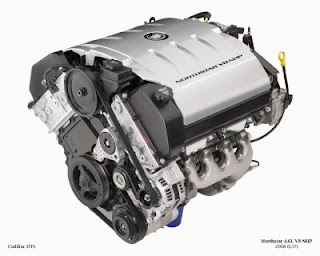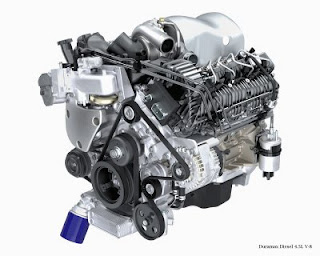35 mpg CAFE Claims Its First Victim
By Chris Haak
01.04.2008
GM announced that it has canceled its program to create a next-generation DOHC V8 engine family for its luxury cars. The engines, known as the “Ultra V8s,” were to be built at the Tonawanda, NY plant and were architecturally related to the so-called 3.6 liter “high feature V6” family found in the Cadillac CTS, STS, SRX, and many other newer GM products. This architectural relationship would not only have shaved development time and costs, but also reduced production costs, while still resulting in a competitive engine. The Northstar is an expensive engine for GM to produce, as it is not related to any other engines in GM Powertrain’s lineup.
 The new engine, which was to be built in Tonawanda after GM announced a $300 million investment in the facility in January 2007, with production scheduled to begin in 2009, was to have been a replacement for the 16 year old Northstar (pictured at left), which is found in the Cadillac DTS, STS, SRX, and XLR, as well as the Buick Lucerne. Originally, the Northstar’s production was scheduled to end in 2010. The Ultra V8 would likely have had direct injection and had output somewhere around 400 horsepower without turbocharging or supercharging.
The new engine, which was to be built in Tonawanda after GM announced a $300 million investment in the facility in January 2007, with production scheduled to begin in 2009, was to have been a replacement for the 16 year old Northstar (pictured at left), which is found in the Cadillac DTS, STS, SRX, and XLR, as well as the Buick Lucerne. Originally, the Northstar’s production was scheduled to end in 2010. The Ultra V8 would likely have had direct injection and had output somewhere around 400 horsepower without turbocharging or supercharging.
If we are to take GM’s words about this move at face value, then we can lay the blame on CAFE. Kevin Smith, a spokesman for Cadillac, said, “We’ve really seen the V-6 become the predominant engine in sales on the (2008) STS because it’s so close in power to the V-8.”
That doesn’t necessarily mean that a V8 is not needed; it means that the V8 needed an upgrade/replacement. It means that the 302 horsepower V6 in the STS is priced more reasonably than a V8 that is only marginally smoother, heavier, and gets worse fuel economy. Granted, the V8 STS comes with some additional equipment, but the MSRP price difference is $9,420, which is an awful lot of money for 18 more horsepower and a V8 badge on the car (base MSRPs before incentives are $52,775 for the V8 and $53,355 for the V6). EPA fuel economy ratings for the STS V8 are 15 city/24 highway, while they are 17 city/26 highway for the STS V6 (2 miles per gallon better).
There are many other implications for this decision. Most importantly, it shows that Cadillac has abandoned its hope of joining the ranks of BMW, Mercedes-Benz, Audi, Lexus, and Jaguar as true premium luxury cars. Cadillac makes fine automobiles – I’d love to own a 2008 CTS – but the lack of a 7-series, S-class, A8, LS, and XJ competitor slotted above the CTS hampers that ambition. And I really don’t think a V6 – even one with twin turbochargers, a supercharger, or whatever else GM might have up its sleeve – can begin to compete in the full size luxury class.
 The decision also was obviously a blow for the Tonawanda engine plant. However, somewhat softening the blow is the fact that GM has committed to building its new 4.5 liter light duty truck diesel at the same plant (pictured at right). This engine, which will be available after 2009, will improve efficiency over 25% compared to the small block V8 gasoline engines in these applications currently. With more strict CAFE standards a reality, perhaps GM will devote even more resources to the small diesel, which is basically a baby Duramax, and still puts out a ton of stump pulling torque.
The decision also was obviously a blow for the Tonawanda engine plant. However, somewhat softening the blow is the fact that GM has committed to building its new 4.5 liter light duty truck diesel at the same plant (pictured at right). This engine, which will be available after 2009, will improve efficiency over 25% compared to the small block V8 gasoline engines in these applications currently. With more strict CAFE standards a reality, perhaps GM will devote even more resources to the small diesel, which is basically a baby Duramax, and still puts out a ton of stump pulling torque.
On a related note, the rumor mill abounds that another CAFE victim will be GM’s on-again, off-again RWD Impala. Supposedly, plans for the car have now been shelved, disappointing enthusiasts who were hoping for a RWD V8 Impala. To my knowledge, GM has not yet confirmed the RWD Impala’s demise, however.
My guess is that we will continue to see news of high performance vehicle programs biting the dust, victims of increased CAFE fuel economy standards. Will Ford continue its Boss V8 engine program for trucks? Stay tuned.
COPYRIGHT Full Metal Autos – All Rights Reserved




